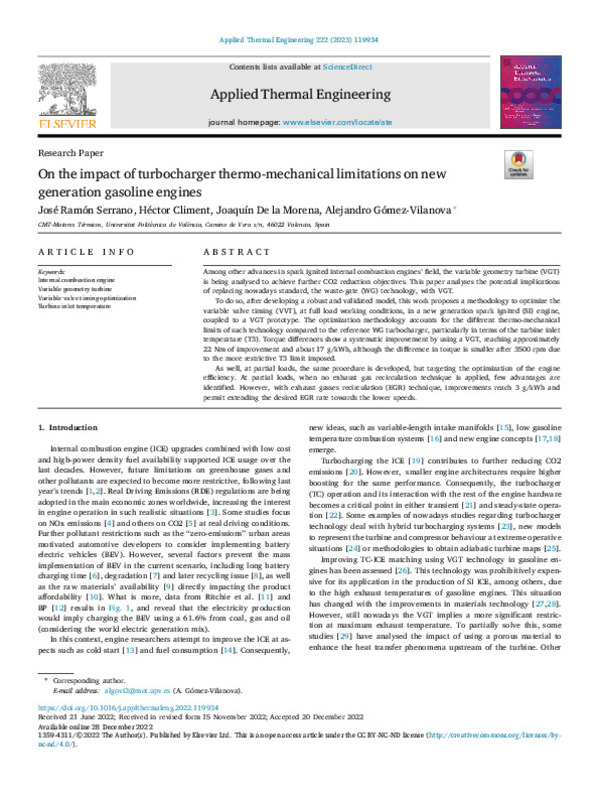JavaScript is disabled for your browser. Some features of this site may not work without it.
Buscar en RiuNet
Listar
Mi cuenta
Estadísticas
Ayuda RiuNet
Admin. UPV
On the impact of turbocharger thermo-mechanical limitations on new generation gasoline engines
Mostrar el registro sencillo del ítem
Ficheros en el ítem
| dc.contributor.author | Serrano, J.R.
|
es_ES |
| dc.contributor.author | Climent, H.
|
es_ES |
| dc.contributor.author | De La Morena, Joaquín
|
es_ES |
| dc.contributor.author | Gómez-Vilanova, Alejandro
|
es_ES |
| dc.date.accessioned | 2024-04-11T07:38:16Z | |
| dc.date.available | 2024-04-11T07:38:16Z | |
| dc.date.issued | 2023-03-05 | es_ES |
| dc.identifier.issn | 1359-4311 | es_ES |
| dc.identifier.uri | http://hdl.handle.net/10251/203316 | |
| dc.description.abstract | [EN] Among other advances in spark ignited internal combustion engines' field, the variable geometry turbine (VGT) is being analysed to achieve further CO2 reduction objectives. This paper analyses the potential implications of replacing nowadays standard, the waste-gate (WG) technology, with VGT.To do so, after developing a robust and validated model, this work proposes a methodology to optimize the variable valve timing (VVT), at full load working conditions, in a new generation spark ignited (SI) engine, coupled to a VGT prototype. The optimization methodology accounts for the different thermo-mechanical limits of such technology compared to the reference WG turbocharger, particularly in terms of the turbine inlet temperature (T3). Torque differences show a systematic improvement by using a VGT, reaching approximately 22 Nm of improvement and about 17 g/kWh, although the difference in torque is smaller after 3500 rpm due to the more restrictive T3 limit imposed.As well, at partial loads, the same procedure is developed, but targeting the optimization of the engine efficiency. At partial loads, when no exhaust gas recirculation technique is applied, few advantages are identified. However, with exhaust gasses recirculation (EGR) technique, improvements reach 3 g/kWh and permit extending the desired EGR rate towards the lower speeds. | es_ES |
| dc.description.sponsorship | Acknowledgements This research has been supported by Grant PID2020-114289RB-I00 funded by MCIN/AEI/10.13039/501100011033. The authors wish to thank Vicente Esteve Ferrer for his invaluable work during the experimental campaign | es_ES |
| dc.language | Inglés | es_ES |
| dc.publisher | Elsevier | es_ES |
| dc.relation.ispartof | Applied Thermal Engineering | es_ES |
| dc.rights | Reconocimiento - No comercial - Sin obra derivada (by-nc-nd) | es_ES |
| dc.subject | Internal combustion engine | es_ES |
| dc.subject | Variable geometry turbine | es_ES |
| dc.subject | Variable valve timing optimization | es_ES |
| dc.subject | Turbine inlet temperature | es_ES |
| dc.subject.classification | MAQUINAS Y MOTORES TERMICOS | es_ES |
| dc.title | On the impact of turbocharger thermo-mechanical limitations on new generation gasoline engines | es_ES |
| dc.type | Artículo | es_ES |
| dc.identifier.doi | 10.1016/j.applthermaleng.2022.119934 | es_ES |
| dc.relation.projectID | info:eu-repo/grantAgreement/AEI/Plan Estatal de Investigación Científica y Técnica y de Innovación 2017-2020/PID2020-114289RB-I00/ES/INTEGRACION DE SISTEMAS DE POST-TRATAMIENTO DE GASES DE ESCAPE MULTIFUNCIONALES EN VEHICULOS DE PROPULSION HIBRIDA/ | es_ES |
| dc.rights.accessRights | Abierto | es_ES |
| dc.contributor.affiliation | Universitat Politècnica de València. Escuela Técnica Superior de Ingeniería del Diseño - Escola Tècnica Superior d'Enginyeria del Disseny | es_ES |
| dc.description.bibliographicCitation | Serrano, J.; Climent, H.; De La Morena, J.; Gómez-Vilanova, A. (2023). On the impact of turbocharger thermo-mechanical limitations on new generation gasoline engines. Applied Thermal Engineering. 222. https://doi.org/10.1016/j.applthermaleng.2022.119934 | es_ES |
| dc.description.accrualMethod | S | es_ES |
| dc.relation.publisherversion | https://doi.org/10.1016/j.applthermaleng.2022.119934 | es_ES |
| dc.type.version | info:eu-repo/semantics/publishedVersion | es_ES |
| dc.description.volume | 222 | es_ES |
| dc.relation.pasarela | S\480209 | es_ES |
| dc.contributor.funder | AGENCIA ESTATAL DE INVESTIGACION | es_ES |
| dc.contributor.funder | Universitat Politècnica de València | es_ES |








